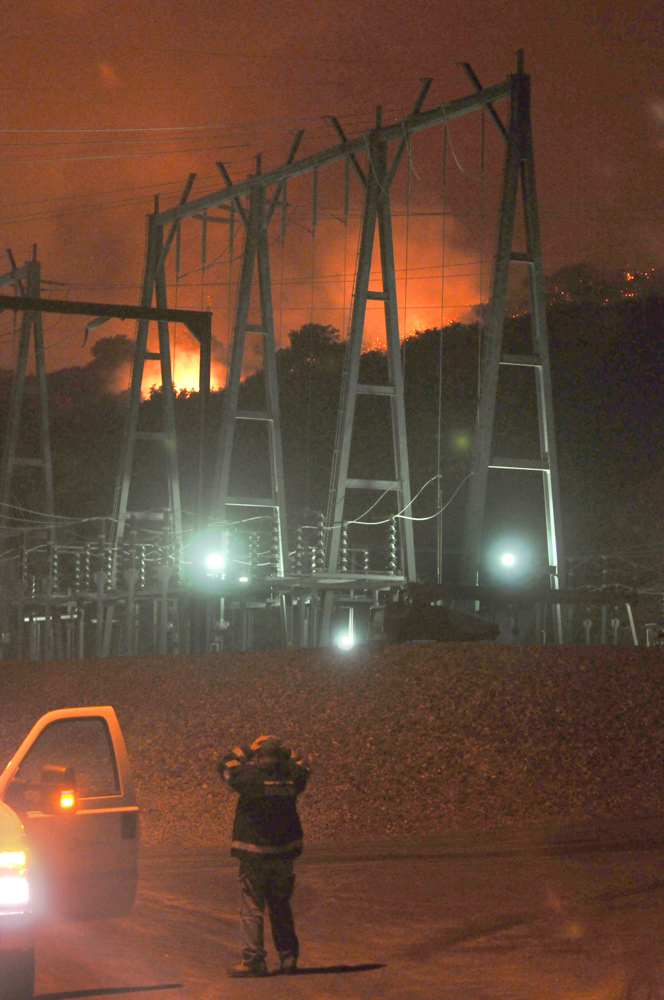Edison to Shut Down Power During Extreme Fire Weather
Drastic Measure Deemed 'Lesser of Two Evils'

Desperate times call for desperate measures, and given California’s new reality of a violent, never-ending fire season wrought by global climate change, Southern California Edison has implemented a controversial public-safety strategy of shutting off power when the weather turns dangerous. “As an electrical company, we pride ourselves on keeping the lights on,” Edison’s Bill Chiu told the Santa Barbara City Council last Tuesday. “This goes against all our instincts.”
Edison’s announcement comes on the heels of a finding by state investigators that live PG&E power lines rattled by strong winds sparked October 2017’s deadly wildfires in Northern California, and just as Edison is addressing multiple lawsuits alleging that on a particularly hot and dry Red Flag day last December its equipment triggered the Thomas Fire, which created the conditions for the 1/9 Debris Flow that killed 23 Montecito residents.
A Public Safety Power Shutoff — or PSPS, as the company calls it — is a “mitigation of last resort,” Chiu emphasized. “We only exercise these when there are not other means to protect the community.” Edison recently ordered two shutoffs, Chiu said, both down in the southern reaches of its coverage area; the policy had existed but not been used for years. At the recommendation of the California Public Utilities Commission, PG&E is also now initiating blackouts during fire weather. San Diego Gas & Electric Co. has been doing so since 2007. The need for a shutdown will be determined by an area’s weather conditions, vegetation density, and other public protection considerations, such as evacuations and firefighter response.
“There is no doubt about it,” Chiu said, “there is a safety trade-off here. We’re looking for the lesser of two evils.” The decision would be made in close consultation with emergency managers and government representatives, he explained. “We will take everything under advisement.”
Chiu said the number of customers affected is entirely situational. But he said a PSPS typically hits “multiple circuits,” explaining the average circuit serves roughly 2,000 homes. “We’re talking about tens of thousands of customers impacted,” he said, potentially including downtown homes and businesses connected to the same circuits that power houses in high-fire-risk areas in the foothills. Based on historical weather data, Chiu forecasted Edison might order between two and ten shutdowns a year throughout its entire coverage area.
Before power can be turned back on, Edison crews must visually inspect power lines to ensure no vegetation or other debris have blown onto the wires. That could take a day or two, in some cases even three or four. “The weather will dictate the duration,” Chiu said. Edison’s last PSPS took place in December 2017 in Idyllwild. Approximately 5,000 residents were without power for 34 hours. Ideally, Chiu said, customers will receive a warning 24-48 hours in advance, but he warned if the weather suddenly turns, that may not be possible.
While Edison has framed the issue as a public-safety matter, there are also financial implications. The move could shield the utility from massive liability. In California, utilities can be held fully responsible for all costs involved in fighting a fire if their equipment was involved in the cause, regardless of whether the equipment was faulty or working properly. Edison CEO Pedro Pizarro and other utility heads are actively petitioning the Public Utilities Commission and legislators to change the law, warning that huge financial payouts — like the $2.5 billion PG&E is about to dole out — could bankrupt them.
As he wrapped up his presentation to the City Council, Chiu touted the “system hardening” Edison is carrying out to better protect its equipment from man-made or natural disasters — installing fire-resistant poles, covering conductors, insulating wires, and so on. He also discussed the utility’s new weather stations and live video feeds.
Mayor Cathy Murillo thanked Chiu for his company’s work but was quick to ask what took them so long. “Some of us wonder why you haven’t done that yet,” she said. “We’ve had sundowner [winds] and fire threats for a very long time.” Councilmember Kristen Sneddon asked Chiu if he thought a preemptive blackout may have prevented the Thomas Fire. Chiu said he couldn’t comment because of the pending litigation.
Edison staff briefed Santa Barbara emergency managers in June and are now working with the county’s Office of Emergency Management to pinpoint where circuits overlay critical infrastructure, including water pumps, hospitals, and evacuation centers, so as to avoid killing power to those facilities in the event of a PSPS. The utility is in close contact with customers who require intensive in-home medical care, said Edison representative Rondi Guthrie. Cottage Health spokesperson Maria Zate said all of its hospitals are able to run on emergency generators for at least 96 hours and have fast access to additional fuel.
411
Edison is hosting a public education workshop this Wednesday, August 15, 6:30-8:30 p.m, at the Earl Warren Showgrounds, where they will describe precautions homeowners can take if they know a blackout is coming — making sure mobile phones and laptops are fully charged, stockpiling water and food that doesn’t require refrigeration, and parking their cars outside their garages, since garage-door openers won’t work.


